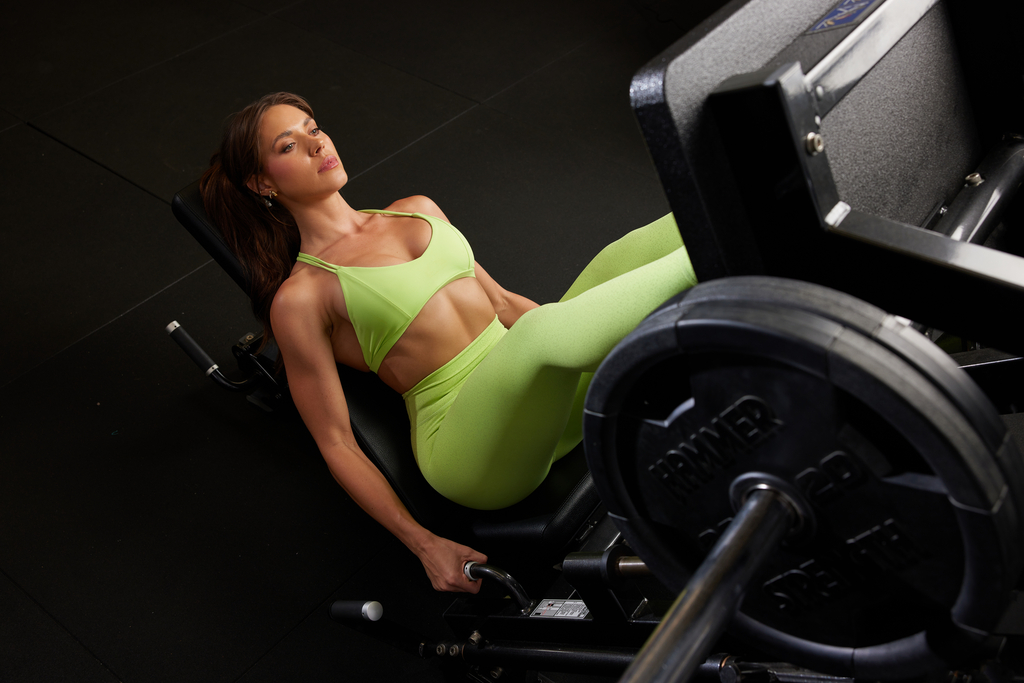There’s a reason why strength training is one of the most popular training styles on the YogaFokus app – it feels good.
There are several different ways of building muscular power and endurance that fall under the strength training umbrella, such as heavy lifting, HIIT, plyometrics or progressive overload.
YogaFokus trainers Kelsey Wells and Katie Martin are both big fans of hypertrophy training and it’s a fundamental part of how they design their YogaFokus programs. Hypertrophy training is geared towards increasing muscle size, and is an empowering, sustainable, and low-impact way to work out.
“When I discovered hypertrophy training, I knew I had to create my PWR program so I could share it with women, and help them feel confident with this training style to increase strength, endurance and definition,” says Kelsey.
“I truly believe this style of training is something you can include in your life and keep doing for years.”
Let’s dive into the difference between hypertrophy and strength training, and everything you need to know to get started.
Hypertrophy vs strength training: what’s the difference?
Although hypertrophy training involves weight lifting and can definitely increase your strength, the primary goal is all about increasing muscle size. You’ll find hypertrophy programs are structured differently to a program that is primarily focused on building muscle strength and lifting heavier weights.
A workout geared towards strength gains will typically include:
-
Heavier weights (lifting 80-100% of your one-rep-max is recommended for strength increases)
-
A low number of repetitions (generally between 1-5 reps). If you’re lifting heavy enough, you shouldn’t be able to complete a high number of reps
-
Longer rest periods between sets
A workout geared towards muscle growth or hypertrophy will typically include:
-
A moderate number of repetitions to spend more time under tension to encourage growth (generally between 8-15 reps)
-
Three or more sets
-
Using weights that feel challenging but don’t push you to your max (around 60-80% of your one-rep-max is recommended)
-
Shorter rest periods between sets or a superset structure. Kelsey and Katie incorporate a variety of supersets, tri-sets, pyramid sets, circuits and burnouts in their programs
Hypertrophy and strength training can be complementary — including both in your routine can help to accelerate gains in both muscle size and strength if your goal is to improve in both respects.
When will you see results from hypertrophy training?
“When I first began to exercise, I felt the benefits of working out long before I saw any physical changes,” says Kelsey. We know that muscle growth is definitely a gradual process that requires patience and commitment. Stick to these fundamentals and you’ll be well on your way:
-
Follow a structured program designed for hypertrophy
-
It’s okay to miss the odd workout, but generally you need to be consistent to see results
-
Focus on eating enough protein each day with a variety of different protein sources across your meals
-
Have a dedicated rest day each week – remember, your muscles recover and grow in between your workouts, not during them
-
Muscle tissue weighs more than fat tissue, so if you want to see physical changes, it can help to take photos or measurements rather than use the scales
-
Although your focus is more on increasing muscle size than strength, you should still notice your strength has definitely improved after a few weeks and you may feel ready to increase your weights to continue feeling challenged
“It’s important to remember that not all progress is linear and making gains every single week is not expected,” Katie says.
How much weight should you lift?
Weight selection is an important part of hypertrophy training and can help you get the most out of every workout to achieve results faster.
You should choose weights that are heavy enough to feel challenging (especially for the last few reps of each set) but still allow you to perform every single rep with correct form.
“Being consistent with your form and technique will go much further than increasing the weight to the detriment of the quality of your movement. Good form before anything else… ALWAYS!”
If your form is poor or you can’t complete the full range of reps, go lighter. If you don’t need the required rest time or each set feels easy, you might want to go heavier. If you’re just starting out, it will take some trial and error to find that sweet spot so don’t be afraid to change your weights if they’re not right for you.
Katie recommends lifting at roughly 70% of your 1RM or one rep max – that’s the heaviest you can lift with correct form for a single rep. Over time, what was once challenging will feel easy – a sign you’re ready to lift heavier! This is the magic of progressive overload in action.
Benefits of hypertrophy training
Here are some of Kelsey, Katie and the YogaFokus Community’s top reasons why they have fallen in love with this style of weight training:
-
It helps to build muscle mass and improve overall body composition
-
It can help to maintain bone density and avoid osteoporosis, which is particularly important for women as they get older
-
It’s low-impact, meaning it’s still very challenging without being hard on your joints (or noisy for your neighbours!)
-
It’s sustainable and a way of training you can continue to enjoy for years to come without feeling burnt out
-
It’s empowering – building strength is a great mood and confidence booster
“There’s something so empowering about seeing what you are capable of, physically and mentally,” says Katie.
Work out anywhere, anytime with YogaFokus
Ready for your first workout?
Consistency is key
Excited to try one of Katie or Kelsey’s programs and see what all the hype is about? Start your YogaFokus journey today and get ready to build muscle, confidence and a workout routine you truly love.
It takes discipline, consistency and a commitment to yourself — but then again, what worth having doesn’t?

